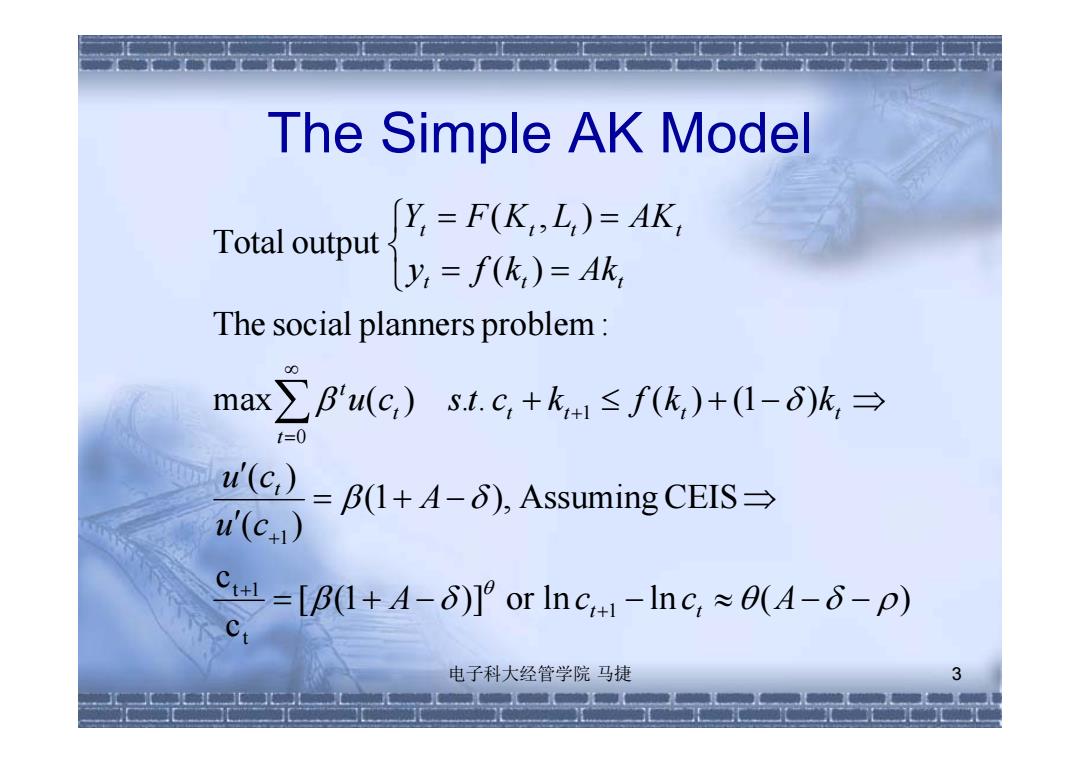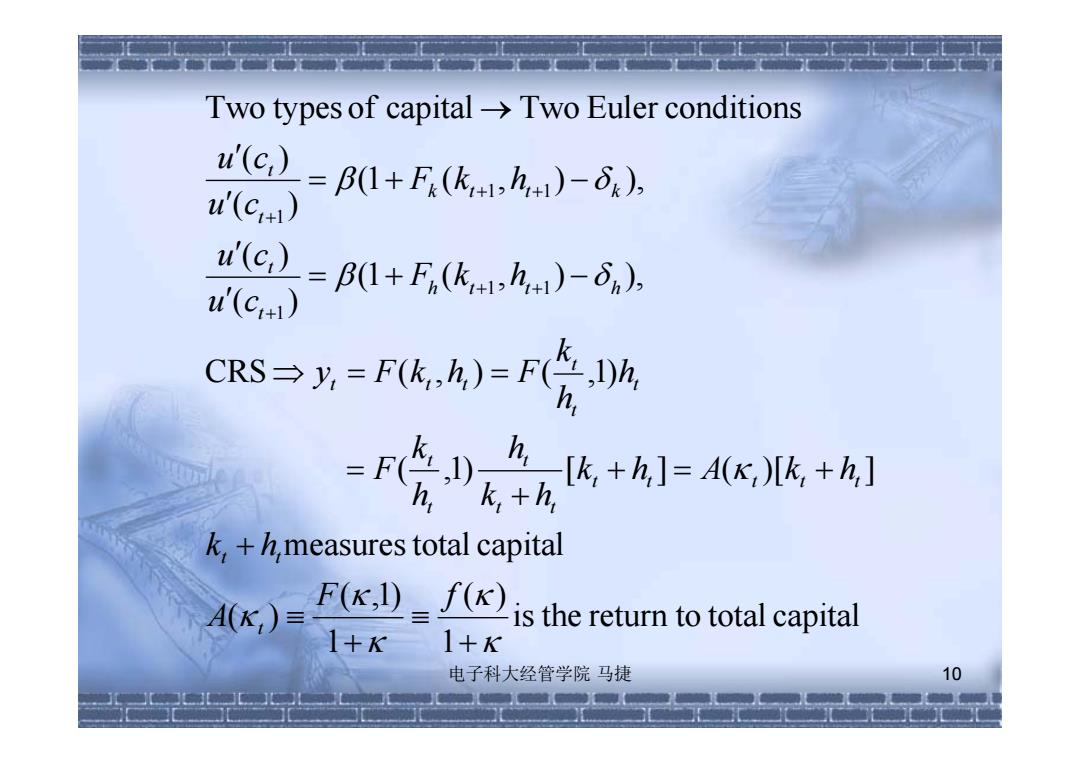
ADVANCED MACROECONOMICS Lecture 4 New Growth Theory 电子科大经管学院马捷
ADVANCED MACROECONOMICS Lecture 4 New Growth Theory 电子科大经管学院 马捷 1

Outline ·AK model 0 Model with human capital Learning by doing The Romer model Aghion-Howitt model 电子科大经管学院马捷 2 元元元元元
Outline AK model Model with human capital Learning by doing The Romer model Aghion-Howitt model 电子科大经管学院 马捷 2

The Simple AK Model Y=F(KL)=AK Total output y=f(k )Ak The social planners problem: max∑B'u(c,)s.t.c,+k+1≤f(k,)+(1-o)k,→ t=0 u'(c)B(1+A-5),Assuming CEIS W'(c) cL-[BI+A-δ)°or Ine,1-lnc,≈(A-6-p) C 电子科大经管学院马捷 3 己元元
The Simple AK Model 电子科大经管学院 马捷 3 [ ( 1 )] or ln ln ( ) c c ( 1 ), Assuming CEIS ( ) ( ) max ( ) . . ( ) ( 1 ) The social planners problem: ( ) ( , ) Total output 1 t t 1 1 1 0 A c c A A u c u c u c s t c k f k k y f k Ak Y F K L AK t t t t t t t t t t t t t t t t t

The resource constraint c,+k+l=(l+A-δ)k,→ G=0-0+A-k→1-知= k+1=s(1+A-δ)k k,y To ensure perpetual growth,we thus need B(1+A-6)>1orA-6>p Otherwise,the economy would shrink at a constant rate to 0 电子科大经管学院马捷
电子科大经管学院 马捷 4 at a constant rate to 0 Otherwise,the economy would shrink (1 ) 1or To ensure perpetual growth, we thus need (1 ) (1 )(1 ) The resource constraint (1 ) 1 1 1 1 1 A A y y k k c c k s A k c s A k c k A k t t t t t t t t t t t t t

C,+k+1=(1+A-δ)k,→ +k1=1+A-0) k,k k=9 K L=[B1+A-δ)]→s=B(1+A-δ)91 C C,=(1-S1+A-δ)k, To ensures∈(0,1),we impose B(l+A-6)-<1 电子科大经管学院马捷 5
电子科大经管学院 马捷 5 To ensure s (0,1), we impose ( 1 ) 1 ( 1 ) ( 1 )( 1 ) [ ( 1 )] ( 1 ) ( 1 ) 1 1 1 1 1 1 A s A c s A k A c c k k A k k k c c k A k t t t t t t t t t t t t t

The Competitive Economy There is a large number of competitive firms,each with access to the same AK technology.The equilibrium rental rate of capital and the equilibrium wage rate are then simply given by r=4 and w=0. The arbitrage between bonds and capital implies that the interest rate is R=r-δ=A-δ. 电子科大经管学院马捷 6
The Competitive Economy There is a large number of competitive firms, each with access to the same AK technology. The equilibrium rental rate of capital and the equilibrium wage rate are then simply given by r = A and w =0. The arbitrage between bonds and capital implies that the interest rate is R = r − δ = A − δ. 电子科大经管学院 马捷 6

Proposition 4.1 Consider an AK economy with CEIS preferences and suppose that (B,0,4, satisfy B(1+4-6)>1>B(1+A-6)0-1.Then, the equilibrium is pareto efficient and the economy exhibits a balanced growth path Capital,output,and consumption all grow at a constant rate,which is given by [B (1 +4-5)] 1.And we have c=(1-s)(1+4-6)k k+1=S(1+A-δ)k, S=B(1+A-6)9- 电子科大经管学院马捷
Proposition 4.1 Consider an AK economy with CEIS preferences and suppose that (β, θ, A, δ) satisfy β (1 + A − δ) > 1 >βθ (1 + A − δ)θ-1 . Then, the equilibrium is pareto efficient and the economy exhibits a balanced growth path. Capital, output, and consumption all grow at a constant rate, which is given by [β (1 + A − δ)]> 1. And we have 电子科大经管学院 马捷 7 1 1 (1 ) (1 ) (1 )(1 ) s A k s A k c s A k t t t t

What is next Single type of capital and single sector of production.>Multiple types of capital and multiple sectors. “Endogenize”the capital K and the productivity A-in terms of physical versus human capital,intentional capital accumulation versus unintentional spillovers,innovation and knowledge creation,etc. 电子科大经管学院马捷 8
What is next ? Single type of capital and single sector of production. Multiple types of capital and multiple sectors. “Endogenize” the capital K and the productivity A— in terms of physical versus human capital, intentional capital accumulation versus unintentional spillovers, innovation and knowledge creation, etc. 电子科大经管学院 马捷 8

Model of Human Capital Total output Y=F(K H )=F(KhL) y =F(k h)=Ak, The resource constraint:c+y k41=(1-6)k,+i → h1=(1-66)h,+ 00 The social planners problem:max(c) 1=0 St.C,+k1+h1≤F(k,h,)+(1-6)k,+(1-δh)h, 电子科大经管学院马捷 9 元元元
Model of Human Capital 电子科大经管学院 马捷 9 t t t t t k t h t t t t h t h t t k t k t t t h t k t t t t t t t t t t t t s t c k h F k h k h u c h h i k k i c i i y y F k h Ak Y F K H F K h L . . ( , ) ( 1 ) ( 1 ) The social planners problem: max ( ) ( 1 ) ( 1 ) The resource constraint : ( , ) ( , ) ( , ) Total output 1 1 0 1 1

Two types of capital->Two Euler conditions c)=Bl+Fkh.)-d,为 W'(c+) c)=Bl+F(k,h)-d, u'(c,+) CRS→y=Fk,h)=F(,h =r哈小爱长+1=k+ k,+h,measures total capital 4()= F(is the return to total capital 1+K 1+K 电子科大经管学院马捷 10
电子科大经管学院 马捷 10 is the return to total capital 1 ( ) 1( ,1) ( ) measures total capital ( ,1) [ ] ( )[ ] CRS ( , ) ( ,1) (1 ( , ) ), ( ) ( ) (1 ( , ) ), ( ) ( ) Two types of capital Two Euler conditions 1 1 1 1 1 1 F f A k h k h A k h k h h h k F h h k y F k h F F k h u c u c F k h u c u c t t t t t t t t t t t t t t t t t t t h t t h t t k t t k t t